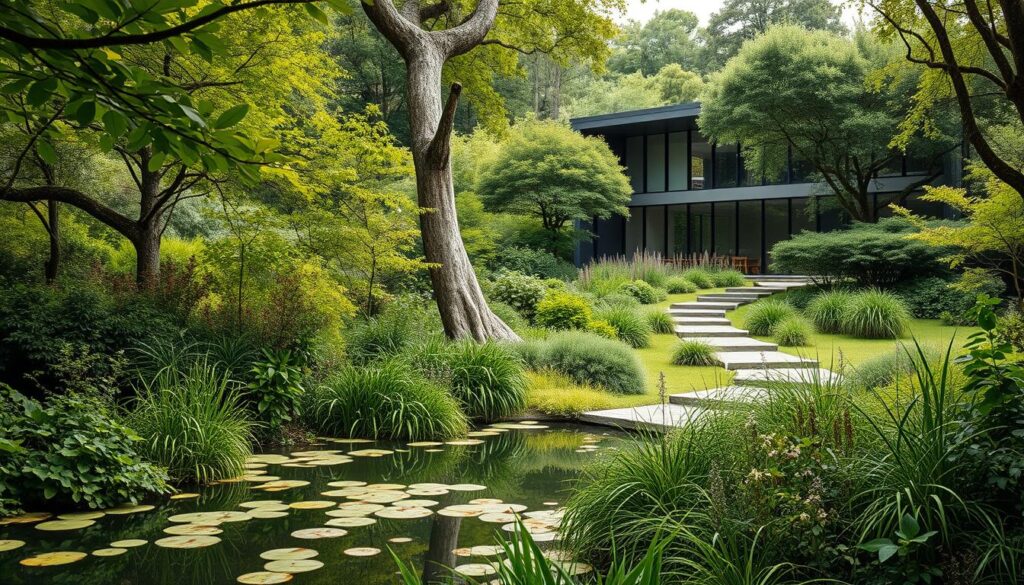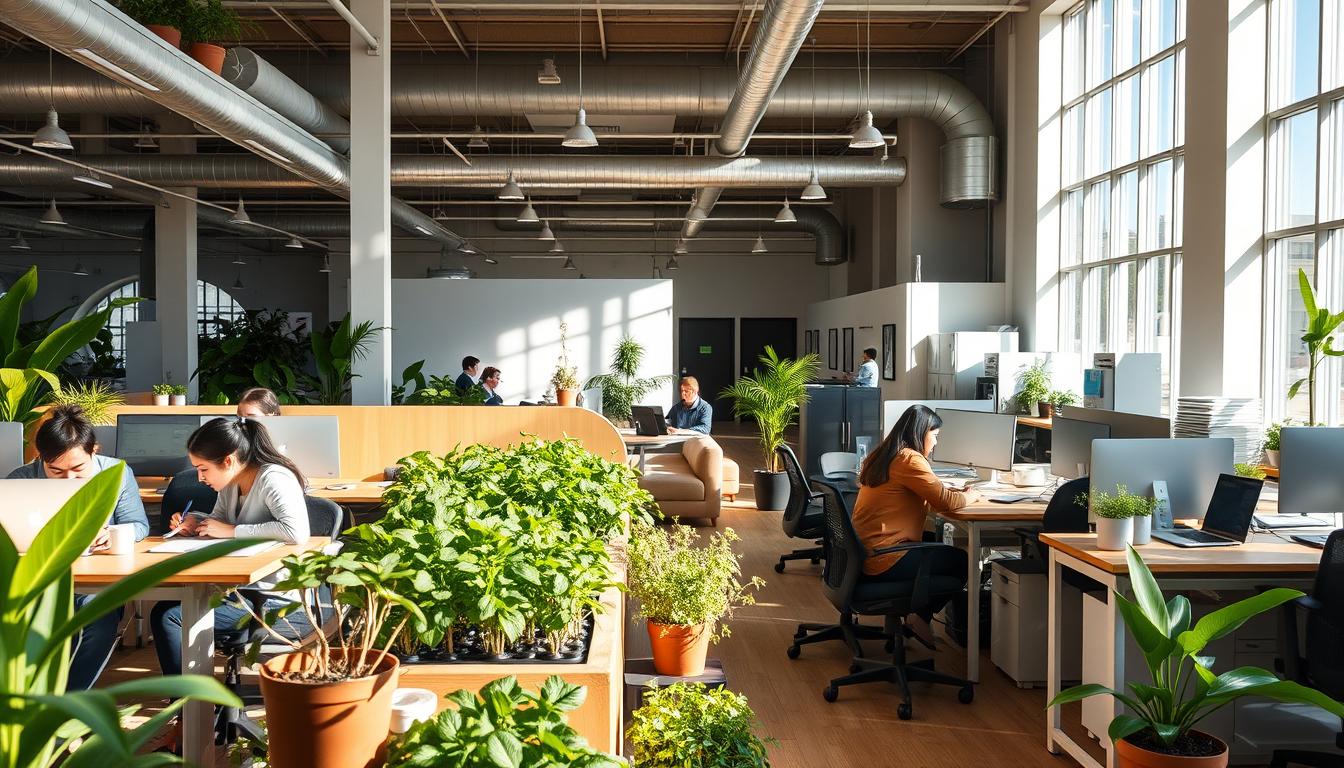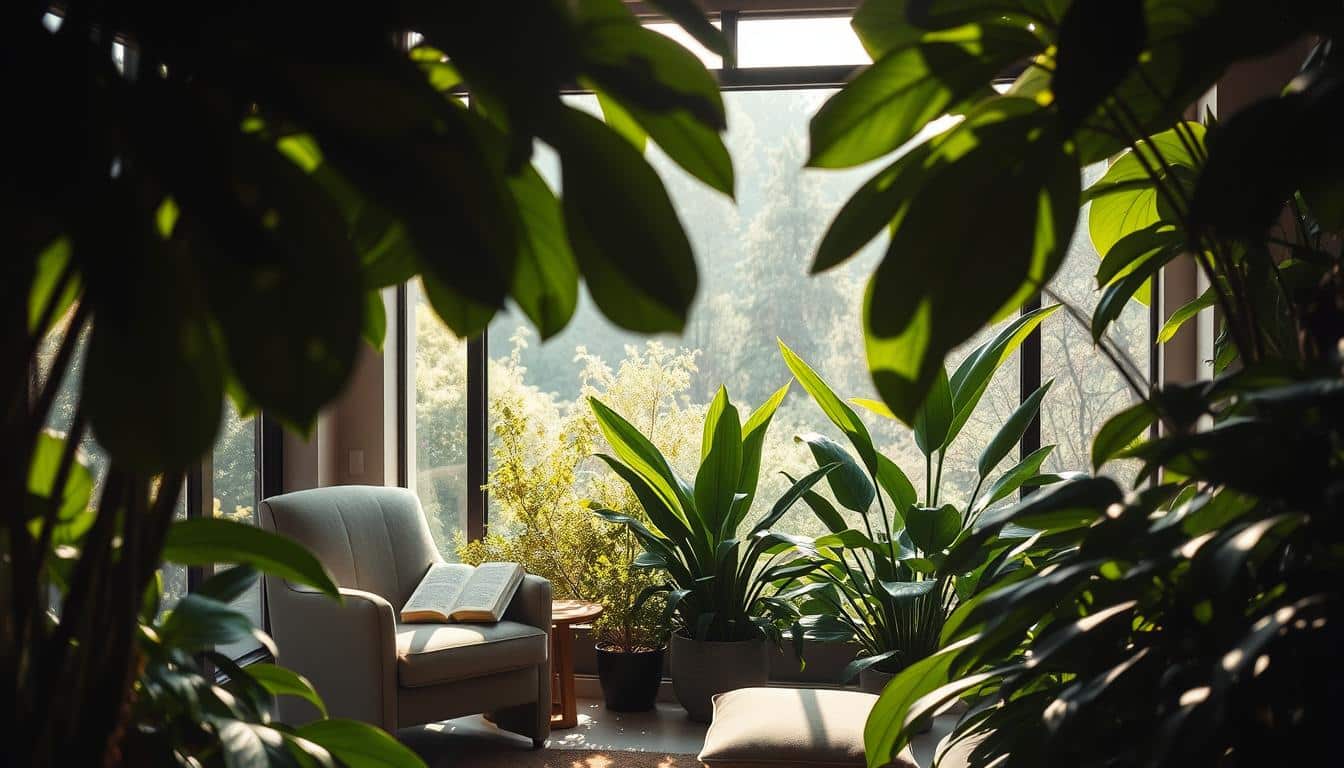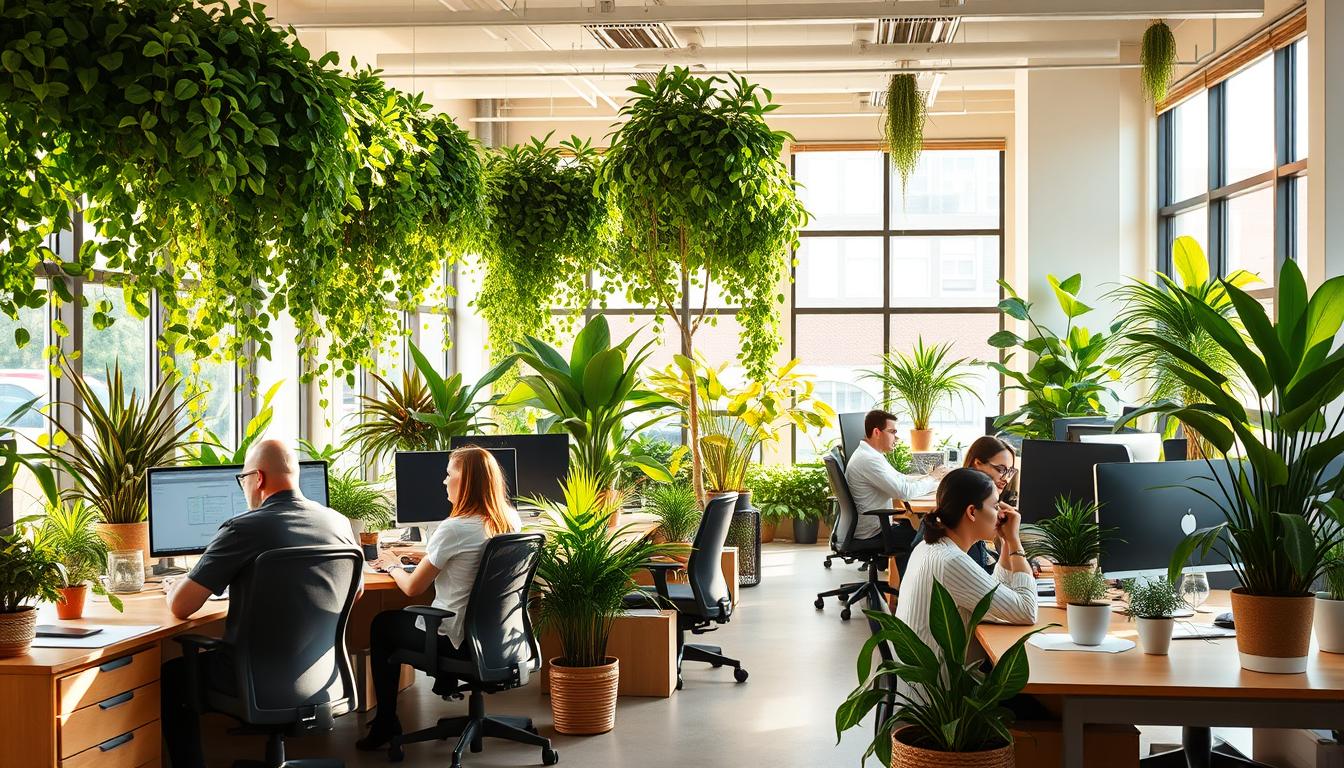Biophilic design blends nature with our buildings. It makes people feel close to nature, boosting happiness and health. In cities, adding nature into designs is more important than ever. It helps us and the earth by promoting health and taking care of the planet.
Introduction to Biophilic Design
Biophilic design is an exciting idea in architecture. It aims to blend nature into our buildings and spaces. This method connects people with their environment by adding natural features into the design. Biophilia, introduced by biologist E.O. Wilson, stresses our deep link with nature.
Designers use nature in their plans to make spaces feel more outdoorsy and healthy. Including nature in interiors improves experiences, lowers stress, and boosts work output. As we understand more about how surroundings impact us, biophilic design becomes key. It makes indoor areas celebrate and harness the goodness of nature.

The Importance of Nature in Urban Life
Urbanization is changing our cities, making nature in them more important. Nature provides a refreshing break from concrete and steel. By adding natural elements, urban planners can make city living better for our mental health.
Green spaces like parks and gardens are key to beating city stress. They clean the air and give us places to relax and play. Being around nature makes us happier and less anxious, improving city life beyond just looking nice.
When cities focus on nature, communities grow stronger. Green spaces help neighbors connect and feel they belong together. In crowded cities, this connection is vital. By using biophilic design, cities can build social ties and tackle urban challenges.
Understanding Biophilia and Its Relevance
Biophilia explores our deep bond with the environment. It’s not just about liking nature’s look. It’s essential for our mental and emotional well-being. Studies show that nature in our spaces improves our mind’s work and lowers stress. These spaces also make us choose healthier lifestyles, boosting our overall health.
It’s crucial to include biophilia in today’s design. Adding nature to city spaces improves people’s experiences and feelings of peace. For communities chasing sustainability, biophilia sheds light on designing with health and the planet in mind.
Benefits of Biophilic Design
Biophilic design has amazing benefits for both personal well-being and work output in many places. It greatly boosts mental health. Having plants and natural light around can make us feel less stressed and more at peace. People feel less anxious and happier when they’re around nature.
Nature doesn’t just help us feel better; it also makes us work better. Offices with biophilic design see big jumps in productivity. Being around natural elements sparks creativity and helps people focus more. This leads to better work and happier employees.
The positive effects on mental health and work efficiency make a strong argument for using biophilic design. It’s great for offices and homes alike.
Biophilic Design for Environmental Satisfaction
Biophilic design is key to making healthy places that make people feel good. It combines nature with architecture and urban planning. Including things like plants, water, and sunlight, spaces become havens. They improve our experiences and are good for the planet too.
Choosing sustainable materials is important for biophilic design. It lessens the environmental impact while making spaces where people love to be. This balance makes us feel closer to nature when we’re inside.
Biophilic design boosts happiness and helps the earth. It brings nature into our daily spaces. This leads to a brighter future and a better way to relate to the environment.
Implementing Biophilic Design in Workspaces
Adding biophilic design in work areas changes the way employees relate to their space. Making the most of natural light is a key part of good office design. It cuts down on the need for fake light and can boost employee happiness. Studies show that when people have access to natural daylight, they feel better about their work, perform better, and have higher well-being.
Bringing the natural world inside is very important. It makes nature an essential part of improving work output and creativity. Here’s how to do it:
- Incorporating large windows or skylights to maximize sunlight exposure.
- Integrating indoor plants and green walls to bring the outdoors inside.
- Utilizing natural materials like wood and stone in furniture and design.
These methods do more than just make spaces look nice. They help people feel connected to the natural world, which is key in making a healthy work environment. By valuing nature in workplaces, companies can create spaces that boost employee well-being and improve how well the organization does.
Sustainable Materials in Biophilic Design
Biophilic architecture blends nature with urban spaces. It values beauty and the health of people living there. An important practice in this approach is using sustainable materials. These help make spaces that are friendly to the environment. They ensure that building practices care for nature.
Choosing sustainable materials like wood from responsible sources and recycled items reduces buildings’ bad effects on nature. These materials make indoor air cleaner. They cut down harmful substances that harm our health. Plus, they make both builders and residents feel more connected to nature around them.
Some great sustainable materials are:
- Reclaimed wood from old structures
- Recycled metal and glass
- Bamboo flooring, known for its quick growth
- Low-VOC paints and finishes
- Natural insulation choices, like sheep’s wool or cellulose
Using these materials in biophilic design is good for the planet. It also makes spaces feel warmer and more welcoming. The natural looks and feels of these materials link indoor spaces with the outdoors.
Impact of Biophilic Design on Indoor Air Quality
Biophilic design greatly improves indoor air by bringing nature indoors. Adding plants makes spaces look good and cleans the air. These plants take out indoor pollutants like VOCs and add oxygen, making the air better.
This design leads to healthier places to live and work. Adding natural air flow to greenery boosts air movement. This helps lessen problems from Sick Building Syndrome (SBS), making environments more productive.
Both companies and people at home can see big gains in air quality with biophilic design. Using many plants and natural air flow makes spaces beautiful and healthy.
Integrating Water Features for Calming Environments
Water features add a peaceful touch to many places. With indoor fountains or aquariums, we get beauty plus a way to relax. The sound of water helps lower stress and makes spaces more enjoyable.
Introducing water elements turns ordinary spots into peaceful getaways. They make places welcoming and calm. This improves how we feel and brings people closer in shared areas.
Adding water features also means more creative options in decorating. They come in many styles and sizes, fitting right into any area. Homes, offices, or public places become more connected to nature, increasing happiness.
Creating Outdoor Spaces for Connection with Nature
Designing outdoor spaces is key to making our daily life better by connecting us to nature. Spaces like rooftop gardens and courtyard greens are perfect spots to relax and meet friends. They offer a break from city life and a chance to enjoy nature.
When we add natural elements to these areas, we make them more inviting. Places to sit surrounded by plants create a peaceful and beautiful setting. Here are some important things to include:
- Seating areas with comfortable furnishings to promote socialization.
- Native plants that require less maintenance and bolster local biodiversity.
- Water features that offer soothing sounds and enhance aesthetic appeal.
- Lighting that highlights natural beauty while ensuring safety.
Investing in the design of outdoor areas improves community health and connects us to the environment. Every new urban garden makes our cities greener and our lives richer.
Biophilic Design and Energy Efficiency
Biophilic strategies help make buildings more energy-efficient. They use nature and sunlight to make spaces. This approach not only helps people feel better but also lowers energy use. Architects work smartly with a building’s placement. This lets in more natural light and air, cutting down the need for lights and air conditioners.
When we use biophilic design, we bring our indoor spaces closer to nature. Things like green roofs, walls full of plants, and smart water use don’t just look good. They also save energy. By designing buildings that match their local climate, they last longer. They meet our needs, respect the environment, and use less energy.
Long-Term Economic Benefits of Biophilic Design
Biophilic design brings great economic benefits over time. Properties embracing nature tend to gain in value, offering a good return on investment. They use natural light, green plants, and organic materials to make spaces welcoming, which boosts occupant happiness.
Such environments boost productivity and well-being, cutting down on absenteeism. More employees at work means more profit for businesses. Healthier workplaces lead to better job performance and financial gains from high-quality design.
Moreover, biophilic design is a star in green building. It attracts people who care about the environment, including stakeholders and investors. This support helps organizations get more funding or incentives, increasing their return on investment in biophilic design.
Conclusion
Biophilic design brings nature into our buildings and cities. It makes places where we live and work better for us and the planet. This way of design fits perfectly with today’s sustainability goals. It makes our spaces more enjoyable.
It’s key for the future to mix natural elements into the places we build. Biophilic design helps with city problems and taking care of the earth. It focuses on benefits for the long run. Using this design idea is crucial for creating green, healthy places.
We’re trying to find a good balance between nature and city life. Biophilic design is our guide. It helps us create spaces that meet our needs and improve our well-being. Architects, designers, and planners will play a big role. They’ll bring these nature-based ideas to life, helping build a better future.



